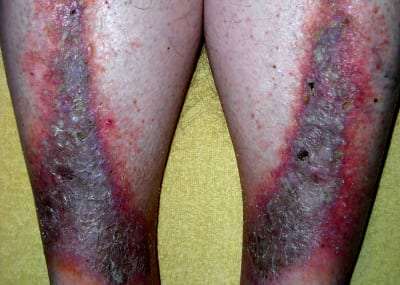 Stasis dermatitis is a common inflammatory skin disease that occurs in the lower extremities. The condition affects a significant proportion of the elderly in the United States and is more prevalent among women and overweight people. Doctors may also refer to the condition as:
Stasis dermatitis is a common inflammatory skin disease that occurs in the lower extremities. The condition affects a significant proportion of the elderly in the United States and is more prevalent among women and overweight people. Doctors may also refer to the condition as:
- Gravitational dermatitis.
- Venous eczema.
- Venous stasis dermatitis.
What Is Stasis Dermatitis?
People with poor blood circulation can develop stasis dermatitis. The condition can occur as a result of varicose veins, congestive heart failure, or other conditions that cause a buildup of fluids. Stasis dermatitis is most common in the lower limbs, where reduced blood flow is most likely to develop. It can occur in just one or both legs. Although rare, stasis dermatitis can develop in other areas of the body.
The legs are most susceptible to developing stasis dermatitis because veins in the legs have built-in one-way valves to help push blood back to the heart. These valves can weaken or even stop working as we age, causing the blood to pool in the veins causing the veins to swell. The swelling produces pressure beneath the skin.
The pressure from the swelling can prevent adequate blood and oxygen from reaching the skin. As pressure continues to build, the pooling blood may leak into the skin, causing the skin to change or discolor. If left untreated, stasis dermatitis can lead to ulcers (open sores) on the skin.
The condition is most often found in the ankles but can spread up to the knees. Stasis dermatitis often affects people with venous insufficiency, such as varicose veins and edema (swelling). However, a diagnosis of venous insufficiency does not necessarily mean stasis dermatitis will develop.
What Causes Stasis Dermatitis?
Stasis dermatitis results from poor circulation or venous insufficiency, which occurs when the leg veins do not work effectively, making it difficult to pump blood back to the heart. Deep vein thrombosis, surgery, or traumatic injury, can severely damage the veins’ function in the legs and lead to venous insufficiency.
Some medical conditions that can increase the risk of developing stasis dermatitis include:
- High blood pressure.
- Being very overweight.
- Heart conditions such as congestive heart failure.
- Kidney failure.
- A previous blood clot, especially in the legs (including deep vein thrombosis).
- Women who have had several pregnancies.
- Past surgery or injury in the area.
- Surgery (to the area or removing a vein from the area).
Stasis dermatitis is more likely to develop in people who stand or sit for long periods or do not get much exercise. Other traits that make it more likely to develop stasis dermatitis include age and gender. People 50 years of age and older and women are more likely to develop it.
What are the Symptoms of Stasis Dermatitis?
The onset of stasis dermatitis can be quick, causing weeping and crusting of the skin. Initially, the patient will notice swelling around the ankles. The swelling may improve after a night’s rest but return during the day and when active.
The symptoms of stasis dermatitis may include those of venous insufficiency:
- Dull aching or heaviness in the leg.
- Pain that gets worse upon standing.
- Swelling in the leg.
Other symptoms can include:
- The skin around or above the ankles looks reddish, yellowish, or brown in color.
- Varicose veins – dark purple or blue twisted, bulging veins in the legs.
- Itching and pain in the area.
- Red, swollen, painful skin or sores that ooze and crust or look scaly.
- Thickened skin around the ankles or shins.
- The skin becomes irritated or cracks when scratched.
- Hair loss on ankles or shins.
If left untreated, stasis dermatitis can gradually worsen, leading to:
- Hard areas of thickened, fibrotic skin.
- Shrinking of the lower part of the leg.
- Deeply pigmented skin.
- Red and scaly skin in the affected area.
- Intense itching of the skin.
- Cellulitis, affecting deeper body tissues, can spread through the leg.
The effect of stasis dermatitis and the application of some medications can cause the skin to become extremely sensitive and painful to touch – a condition known as contact dermatitis.
How is Stasis Dermatitis Treated?
The treatment of stasis dermatitis is usually two-fold. The first is to reduce the pooling of blood in the veins; the second is to treat the symptoms to minimize patient discomfort. Stasis dermatitis is usually a long-term (chronic) condition. However, with a healthy lifestyle, exercise, and a balanced diet, it is possible to manage the condition. In addition, self-care and changes to some daily habits can help get stasis dermatitis under control and prevent it from worsening.
In some cases, surgery may be necessary to repair the veins. If large ulcers have formed, a skin graft may be necessary. To treat pain, redness, and swelling, the doctor may prescribe medicine for topical application. To reduce swelling and the amount of fluid in the legs, a diuretic may be necessary.
The skin discoloration of stasis dermatitis often remains even after the swelling, sores, and other signs have cleared. A dermatologist can suggest treatment options that may help reduce discoloration.
Novus Spine & Pain Center
Dr. Torres established Novus Spine & Pain Center in Lakeland, Florida, with the goal of providing the highest quality pain management care to every patient. Whether pain is the result of an injury or from another condition, Dr. Torres offers many different treatment options.
Novus Spine & Pain Center utilizes a comprehensive approach and cutting-edge therapies to restore normal function and allow patients to regain an active lifestyle while minimizing the need for opiates. As our patient, you are our top priority. Our goal is to help you achieve the best possible quality of life.
Our Mission Statement: To provide the best quality of life to people suffering from pain by providing state-of-the-art treatments, knowledge and skill, compassion, and respect for all.
For your convenience, you may schedule an appointment online, request a call back, or call our office at 863-473-7849.
Stasis Dermatitis Resources
What is Stasis Dermatitis (Web MD)
What is Venous Stasis Dermatitis? (Web MD)
Stasis Dermatitis (Medscape)
Stasis Dermatitis and Ulcers (Medline Plus)
Stasis Dermatitis (Mayo Clinic)
Other Dermatitis Conditions (Johns Hopkins)
Medical Definition of Stasis dermatitis (MedicineNet)
Stasis Dermatitis (American Academy of Dermatology Association)
Varicose eczema, or stasis dermatitis: What you need to know (Medical News Today)
Updated: October 5, 2022

